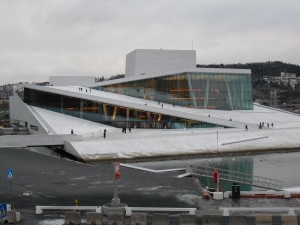In Oslo, an Ultramodern Makeover
“You know, there is more construction here than anywhere in all of Scandinavia,” said Tore Valkeapää, the old Sami shopkeeper running a store out of a massive tent in the middle of central Oslo’s bustling waterfront district.
I smiled approvingly. Somehow, the elderly man’s words seemed right. Everywhere I turned in this ultra-modern city, construction cranes rose like monuments in the soft November sky. Oil revenue is fast turning Norway’s once-quaint capital into the Dubai of Northern Europe, and the evidence is everywhere.
To the casual visitor, the most obvious example of Oslo’s modern resurgence is the Oslo Opera House, a 1,100-room complex built at the head of the Oslofjord, one of the largest of Norway’s famed fjords. Opened in April 2008, it was constructed at a cost of 4.4 billion Norwegian Kroner (approximately $880 million), and is the largest cultural building built in the country since the Nidarosdomen was completed around 1300.
“It definitely attracts a lot of visitors,” said Valkeapää, whose store sits less than 300 meters away.
He’s not kidding: in its first year alone, more than 1.3 million people passed through the Opera’s doors, with many more simply taking photos outside of its low sloping roof, which literally rises out of the ice-cold water. The expressionist-style building has also received considerable international attention from the architectural community, winning both the World Architecture Award in October 2008 and the 2009 Mies van der Rohe Award, the European Union prize for contemporary architecture.
Indeed, the “Tiger City” seems to have adopted a new slogan: bigger, taller, and glitzier — out with the old, in with the new. Already a “young” city by European standards, Oslo has been turning back the clock even more. No better confirmation exists than the under-construction Edvard Munch museum, dubbed “Lambda” by architect Juan Herreros. When completed in 2013, the 14-story museum will replace the current space dedicated to the world-renowned Norwegian painter, which itself first opened in 1963. With promises of sustainable construction and visitor-friendly design, the project has generated virtually no controversy among locals.
I was surprised, to be sure, of just how modern Oslo is becoming. I had decided to spend a day in the city with a couple of friends of mine, and our expectations were decidedly mediocre. Others I’d talked to had described the city as little more than a retail-oriented port with a reputation for being one of the most expensive cities in the world (indeed, it holds the top stop according to The Economist’s 2010 rankings), or worse, a drab capital lost among tourists to the more popular and slightly less expensive Kristiansand and Bergen.
When we first entered the Oslo metropolitan area in the early morning via bus, there wasn’t much to see: Asker looked like a typical bedroom community, and Drammen was a riverside industrial burg. But when we finally reached Oslo, I was awed by a spectacle of high-rise glam and construction that for a moment convinced me that I was looking at a much larger northern city like Berlin or Moscow.
The first thing we did was take a walk. Even at this early hour, the streets were crowded with business people on their way to work and chipper travelers conversing in half a dozen languages. Everything was clean, bright, and functional.
There were little white candles flickering everywhere – even in the cozy cafe where we lingered over a lavish breakfast smorgasbord. According to our preferences, we fortified ourselves with hard-boiled eggs and shrimp salad, with mackerel in tomato sauce and muesli. We refilled our plates and sipped our tea and coffee, reluctant to go out into the winter cold. Candles in silver-stemmed goblets and smoked glass boxes burned on every table, like a promise to hold onto the light right through the frosty autumn morning and the rest of the day.
While my companions endeavored to visit the cultural sites of Oslo, from the National Gallery that houses such Munch masterpieces as The Scream (recently put back on display after being stolen in 2004) to the Stortinget (the seat of the Norwegian parliament) and the Royal Palace, I was determined to discover just exactly what Oslo residents thought of the immense changes taking place in their city.
“It’s hard to imagine, but when I first opened [my store] there were only a couple of T-bane (subway) stops,” said Per Hermansson, owner of Shadowland Records. “Now they’re everywhere.”
(Article continued on next page)

